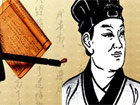| Videos | ? Latest |
|
? Feature | ? Sports | ? Your Videos |
The story of paper

 0 Comment(s)
0 Comment(s) Print
Print E-mail
CNTV, December 12, 2011
E-mail
CNTV, December 12, 2011
In medieval Europe, 300 and more sheets of parchment were used to print a Bible. The bulk, the complicated work and cost limited its circulation.
In China, characters were first engraved on bronze objects, then on bamboo slips or silk. It was said that in ancient times, one letter written to the emperor was done on 3,000 bamboo slips, and had to be carried to the palace by two warriors.
The development of culture called for convenient and inexpensive writing material. Archeological finds proved that China began to produce paper with plant fiber as early as the Western Han period (206BC-23AD). Then, technique was primitive and coarse.
In the Eastern Han period (25-220), Eunuch Cai Lun who headed an imperial workshop improved former papermaking technique. Bark, rope ends and rags were soaked in water, chopped up and boiled. The pulp was dewatered, pressed and dried. This famous Cai Lun paper was light and thin, strong and inexpensive and could be mass-produced. Cai Lun's contribution in the invention and improvement of papermaking technique won him respect from posterity. This invention was a revolution facilitating the circulation of knowledge. Since then our culture began to be written on paper.
With the development of society and culture, paper was widely used and the technique of papermaking continued to improve. Bamboo was used to make paper in later Tang Dynasty (608-907). Bamboo grew rapidly in large quantities. Its long fiber, fine and strong, made it excellent papermaking material. Yet complicated technique was required to make bamboo paper. People continued to look for other materials until they used a mixture of different proportions of many kinds of plant fiber to produce different kinds of paper.
The production of the world-renowned "xuan" paper began in the Tang Dynasty. It is made of windceltis bark and spring water with special technique passed from generation to generation. It is still the best and irreplaceable. "Xuan" paper is soft, white, smooth and absorbent. Paintings done on it hundreds of years ago retain their original splendor. These special features of "xuan" paper are particularly suitable for bringing out the attraction and spirit of Chinese painting, surpassing all paper made with modern technique.
Around the middle of the 3rd century, the technique of papermaking spread to Korea and Vietnam; and then to the West after the 8th century. In 1150, the first paper mill in Europe was set up in Spain. When paper was widespread in Europe, the long medieval age was coming to an end and Renaissance was beginning to dawn.





